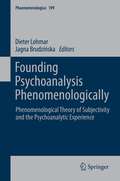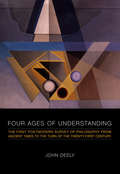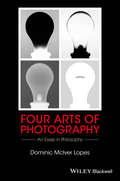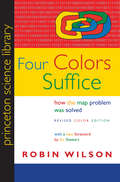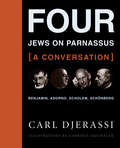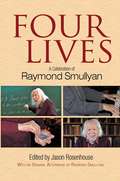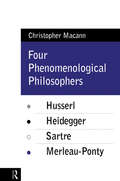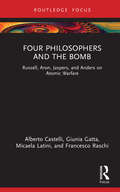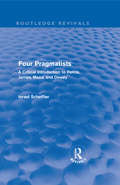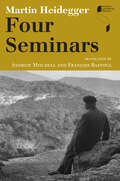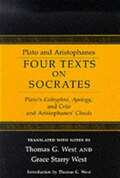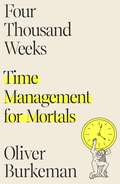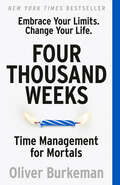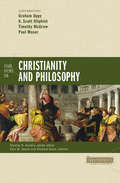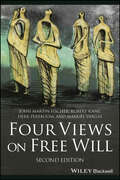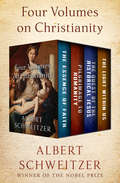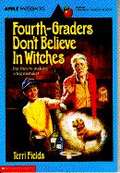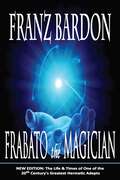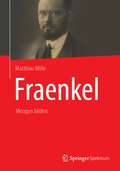- Table View
- List View
Founding Psychoanalysis Phenomenologically
by Dieter Lohmar Jagna BrudzinskaThe present anthology seeks to give an overview of the different approaches to establish a relation between phenomenology and psychoanalysis, primarily from the viewpoint of current phenomenological research. Already during the lifetimes of the two disciplines' founders, Edmund Husserl (1859 - 1938) and Sigmund Freud (1856 - 1939), phenomenological and phenomenologically inspired authors were advancing psychoanalytic theses. For both traditions, the Second World War presented a painful and devastating disruption of their development and mutual exchange. During the postwar period, phenomenologists, especially in France, revisited psychoanalytic topics. Thus, in the so-called second generation of phenomenology there developed an intensive reception of the psychoanalytic tradition, one that finds its expression even today in current hermeneutic, postmodern and poststructuralist conceptions. But also in more recent phenomenological research we find projects concentrated systematically on psychoanalysis and its theses. In this context, the status of psychoanalysis as a science of human experience is discussed anew, now approached on the 'first person' basis of a phenomenological understanding of subjective experience. In such approaches, phenomena like incorporation, phantasy, emotion and the unconscious are discussed afresh. These topics, important for modern phenomenology as well as for psychoanalysis, are examined in the context of the constitution of the human person as well as of our intersubjective world. The analyses are also interdisciplinary, making use of connections with modern medicine, psychiatry and psychotherapy. The systematic investigations are enriched by historical analysis and research in the internal development of the disciplines involved. The volume presents recent work of internationally recognized researchers - phenomenologically oriented philosophers, psychoanalysts and psychotherapists - who work in the common field of the two disciplines. The editors hope that this selection will encourage further systematic collaboration between phenomenology and psychoanalysis
Four Ages of Understanding: The First Postmodern Survey of Philosophy from Ancient Times to the Turn of the Twenty-First Century (Toronto Studies in Semiotics and Communication)
by John DeelyThis book redraws the intellectual map and sets the agenda in philosophy for the next fifty or so years. By making the theory of signs the dominant theme in Four Ages of Understanding, John Deely has produced a history of philosophy that is innovative, original, and complete. The first full-scale demonstration of the centrality of the theory of signs to the history of philosophy, Four Ages of Understanding provides a new vantage point from which to review and reinterpret the development of intellectual culture at the threshold of "globalization". Deely examines the whole movement of past developments in the history of philosophy in relation to the emergence of contemporary semiotics as the defining moment of Postmodernism. Beginning traditionally with the Pre-Socratic thinkers of early Greece, Deely gives an account of the development of the notion of signs and of the general philosophical problems and themes which give that notion a context through four ages: Ancient philosophy, covering initial Greek thought; the Latin age, philosophy in European civilization from Augustine in the 4th century to Poinsot in the 17th; the Modern period, beginning with Descartes and Locke; and the Postmodern period, beginning with Charles Sanders Peirce and continuing to the present. Reading the complete history of philosophy in light of the theory of the sign allows Deely to address the work of thinkers never before included in a general history, and in particular to overcome the gap between Ockham and Descartes which has characterized the standard treatments heretofore. One of the essential features of the book is the way in which it shows how the theme of signs opens a perspective for seeing the Latin Age from its beginning with Augustine to the work of Poinsot as an indigenous development and organic unity under which all the standard themes of ontology and epistemology find a new resolution and place. A magisterial general history of philosophy, Deely's book provides both a strong background to semiotics and a theoretical unity between philosophy's history and its immediate future. With Four Ages of Understanding Deely sets a new agenda for philosophy as a discipline entering the 21st century.
Four Arts of Photography: An Essay in Philosophy (New Directions in Aesthetics)
by Dominic McIver LopesFour Arts of Photography explores the history of photography through the lens of philosophy and proposes a new scholarly understanding of the art form for the 21st century. Re-examines the history of art photography through four major photographic movements and with case studies of representative images Employs a top-down, theory to case approach, as well as a bottom-up, case to theory approach Advances a new theory regarding the nature of photography that is grounded in technology but doesn’t place it in opposition to painting Includes commentaries by two leading philosophers of photography, Diarmuid Costello and Cynthia A. Freeland
Four Colors Suffice: How the Map Problem Was Solved - Revised Color Edition (Princeton Science Library #128)
by Robin WilsonOn October 23, 1852, Professor Augustus De Morgan wrote a letter to a colleague, unaware that he was launching one of the most famous mathematical conundrums in history--one that would confound thousands of puzzlers for more than a century. This is the amazing story of how the "map problem" was solved. The problem posed in the letter came from a former student: What is the least possible number of colors needed to fill in any map (real or invented) so that neighboring counties are always colored differently? This deceptively simple question was of minimal interest to cartographers, who saw little need to limit how many colors they used. But the problem set off a frenzy among professional mathematicians and amateur problem solvers, among them Lewis Carroll, an astronomer, a botanist, an obsessive golfer, the Bishop of London, a man who set his watch only once a year, a California traffic cop, and a bridegroom who spent his honeymoon coloring maps. In their pursuit of the solution, mathematicians painted maps on doughnuts and horseshoes and played with patterned soccer balls and the great rhombicuboctahedron. It would be more than one hundred years (and countless colored maps) later before the result was finally established. Even then, difficult questions remained, and the intricate solution--which involved no fewer than 1,200 hours of computer time--was greeted with as much dismay as enthusiasm. Providing a clear and elegant explanation of the problem and the proof, Robin Wilson tells how a seemingly innocuous question baffled great minds and stimulated exciting mathematics with far-flung applications. This is the entertaining story of those who failed to prove, and those who ultimately did prove, that four colors do indeed suffice to color any map. This new edition features many color illustrations. It also includes a new foreword by Ian Stewart on the importance of the map problem and how it was solved.
Four Exemplars of Ru 儒: Beyond Comparative Philosophy (Chinese Culture #11)
by Hans-Georg Moeller Paul J. D'Ambrosio Geir Sigurðsson Dimitra AmarantidouThis book discusses scholars who have all engaged in comparative philosophy projects, many of whom first rose to fame because of their penetrating insights into the similarities and differences in “Western” and “Chinese” thought. They all went beyond simply looking at how one thinker, one school, or one tradition relates to another: each draws on sources from China and the West. However, their projects—from role ethics to concrete metaphysics, from critiquing individualism to balancing harmony and justice—are attempts at re-evaluating the way we view the world and live our lives. These projects are systematic, thorough tong 通, and comprehensive descriptions of ourselves, the world, and our interactions with others. They are all comparative, but, on top of this, they also aim at making a point that transcends their comparisons. The book thus shows that these great thinkers draw on a multiplicity of resources, and while they might find some ideas closer to home than others, comparison is a necessary constant. Using traditional Confucian vocabulary, this type of philosophizing is described as practicing xue 学, normally understood as “studying” or “learning.” But, it also means to copy, imitate, model, or emulate. In the process of xue, one imitates, but with a nod to differences. This book honors four models of such an attitude to xue. In its examination of some of the most influential scholars in Chinese thought, this is a seminal book for scholars and students in Chinese and comparative philosophy.
Four Jews on Parnassus--A Conversation: Benjamin, Adorno, Scholem, Schönberg
by Carl DjerassiTheodor W. Adorno was the prototypical German Jewish non-Jew, Walter Benjamin vacillated between German Jew and Jewish German, Gershom Scholem was a committed Zionist, and Arnold Schönberg converted to Protestantism for professional reasons but later returned to Judaism. Carl Djerassi, himself a refugee from Hitler's Austria, dramatizes a dialogue between these four men in which they discuss fraternity, religious identity, and legacy as well as reveal aspects of their lives--notably their relations with their wives--that many have ignored, underemphasized, or misrepresented. The desire for canonization and the process by which it is obtained are the underlying themes of this dialogue, with emphasis on Paul Klee's Angelus Novus (1920), a canonized work that resonated deeply with Benjamin, Adorno, and Scholem (and for which Djerassi and Gabrielle Seethaler present a revisionist and richly illustrated interpretation). Basing his dialogue on extensive archival research and interviews, Djerassi concludes with a daring speculation on the putative contents of Benjamin's famous briefcase, which disappeared upon his suicide.
Four Jews on Parnassus—a Conversation: Benjamin, Adorno, Scholem, Schönberg
by Carl DjerassiThis book features a CD of rarely performed music, including a specially commissioned rap by Erik Weiner of Walter Benjamin's "Thesis on the Philosophy of History." Theodor W. Adorno was the prototypical German Jewish non-Jew, Walter Benjamin vacillated between German Jew and Jewish German, Gershom Scholem was a committed Zionist, and Arnold Schönberg converted to Protestantism for professional reasons but later returned to Judaism. Carl Djerassi, himself a refugee from Hitler's Austria, dramatizes a dialogue between these four men in which they discuss fraternity, religious identity, and legacy as well as reveal aspects of their lives-notably their relations with their wives-that many have ignored, underemphasized, or misrepresented. The desire for canonization and the process by which it is obtained are the underlying themes of this dialogue, with emphasis on Paul Klee's Angelus Novus (1920), a canonized work that resonated deeply with Benjamin, Adorno, and Scholem (and for which Djerassi and Gabrielle Seethaler present a revisionist and richly illustrated interpretation). Basing his dialogue on extensive archival research and interviews, Djerassi concludes with a daring speculation on the putative contents of Benjamin's famous briefcase, which disappeared upon his suicide.
Four Lives: A Celebration of Raymond Smullyan
by Raymond M. Smullyan Jason RosenhouseThis "best of" collection of works by Raymond Smullyan features excerpts from his published writings, including logic puzzles, explorations of mathematical logic and paradoxes, retrograde analysis chess problems, jokes and anecdotes, and meditations on the philosophy of religion. In addition, numerous personal tributes salute this celebrated professor, author, and logic scholar who is also a magician and musician.
Four Meditations on Happiness
by Michael HampeIn this original and thought-provoking book, philosopher Michael Hampe sets out to help us understand happiness. The right and proper path to a happy life is a topic that has been debated for millennia. There are many theories, from those of ancient philosophy to those of modern neuroscience, but can any one of them ultimately tell us how the objective of a perfectly fulfilled life might be achieved? By telling the story of two friends—the unhappy philosopher Stanley Low and the happy gardener Gabriel Kolk—alongside a presentation of four essays that examine prominent and very plausible theories of happiness, Michael Hampe illustrates that there is no easy answer to our search for unadulterated bliss. This is an erudite and illuminating investigation into one of mankind's most elusive quests, one that allows us to reconsider what it means to be happy.
Four Phenomenological Philosophers: Husserl, Heidegger, Sartre, Merleau-Ponty
by Christopher MacannMacann guides the student through the major texts of the four great thinkers of the phenomenological movement.
Four Philosophers and the Bomb: Russell, Aron, Jaspers, and Anders on Atomic Warfare (Routledge Studies in Social and Political Thought)
by Alberto Castelli Giunia Gatta Micaela Latini Francesco RaschiIn this book, Alberto Castelli, Giunia Gatta, Micaela Latini, and Francesco Raschi examine how four prominent intellectuals of the 20th century (Bertrand Russell, Karl Jaspers, Raymond Aron, and Günther Anders) understood atomic warfare. With a chapter devoted to the philosophical ideas of each thinker and how they understood and interpreted war, the authors analyze the historic-political context in which these ideas emerged and what they proposed to avoid a nuclear disaster.Four Philosophers and the Bomb will be of interest to students and researchers of peace studies, international relations, political philosophy, and moral philosophy.
Four Pragmatists: A Critical Introduction to Peirce, James, Mead, and Dewey (Routledge Revivals)
by Israel SchefflerFirst published in 1974, this book is a critical introduction to the work of four quintessential pragmatist philosophers: Charles Sanders Peirce, William James, George Herbert Mead and John Dewey. Alongside providing a general historical and biographical account of the pragmatist movement, the work offers an in depth critical response to the philosophical doctrines of the four main thinkers of the pragmatist movement, with reference to the theories of meaning, knowledge and conduct which have come to define pragmatism.
Four Seminars (Studies in Continental Thought)
by Martin HeideggerThe philosopher presents a stimulating overview of his work, its intellectual roots, and its relationship to the work of other twentieth century thinkers.In Four Seminars, Heidegger reviews the entire trajectory of his thought and offers unique perspectives on fundamental aspects of his work. First published in French in 1976, these seminars were translated into German with Heidegger’s approval and reissued in 1986 as part of his Gesamtausgabe, volume 15. Topics considered include the Greek understanding of presence, the ontological difference, the notion of system in German Idealism, the power of naming, the problem of technology, danger, and the event.Heidegger’s engagements with his philosophical forebears—Parmenides, Heraclitus, Kant, and Hegel—continue in surprising dialogues with his contemporaries—Husserl, Marx, and Wittgenstein. While providing important insights into how Heidegger conducted his lectures, these seminars show him in his maturity, reflecting back on his philosophical path.
Four Texts on Socrates: Plato's Euthyphro, Apology and Crito, and Aristophanes' Clouds (Revised Edition)
by Plato Aristophanes Thomas G. West Grace S. WestWidely adopted for classroom use, this book offers translations of four major works of ancient Greek literature which treat the life and thought of Socrates, focusing particularly on his trial and defense (the platonic dialogues Euthyphro, Apology of Socrates, and Crito) and on the charges against Socrates (Aristophanes' comedy Clouds). This is the only collection of the three Platonic dialogues that also includes Clouds, a work that is fundamental for understanding the thought of Socrates in relation to the Athenian political community and to Greek poetry. Thomas G. West's introduction provides an overview of the principal themes and arguments of the four works. There are extensive explanatory notes to the translations. For this new edition, Thomas West has revised the introduction and updated the annotated bibliography, which includes the best of the secondary literature on Socrates and on the texts included in this book. In their translations, the Wests capture successfully the simplicity and vigor of straightforward Greek diction. They strive for as high a degree of accuracy as possible, subordinating concerns for elegance and smoothness to the goal of producing the most faithful and most reliable English versions of these texts.
Four Texts on Socrates: Plato's Euthyphro, Apology, and Crito and Aristophanes' Clouds
by Thomas G. West Grace S. WestWidely adopted for classroom use, this book offers translations of four major works of ancient Greek literature which treat the life and thought of Socrates, focusing particularly on his trial and defense (three dialogues by Plato: Euthyphro, Apology of Socrates, and Crito) and on the charges against Socrates (Aristophanes' comedy Clouds). <p><p> This is the only collection of the three Platonic dialogues that also includes Clouds, a work that is fundamental for understanding the thought of Socrates in relation to the Athenian political community and to Greek poetry. Thomas G. West's introduction provides an overview of the principal themes and arguments of the four works. There are extensive explanatory notes to the translations. In their translations, the Wests capture successfully the simplicity and vigor of straightforward Greek diction. They strive for as high a degree of accuracy as possible, subordinating concerns for elegance and smoothness to the goal of producing the most faithful and most reliable English versions of these texts. <p><p> For this new edition, Thomas West has revised the introduction and updated the annotated bibliography, which includes the best of the secondary literature on Socrates and on the texts included in this book.
Four Thousand Weeks: Time Management for Mortals
by Oliver BurkemanAN INSTANT NEW YORK TIMES BESTSELLER"Provocative and appealing . . . well worth your extremely limited time." —Barbara Spindel, The Wall Street JournalThe average human lifespan is absurdly, insultingly brief. Assuming you live to be eighty, you have just over four thousand weeks.Nobody needs telling there isn’t enough time. We’re obsessed with our lengthening to-do lists, our overfilled inboxes, work-life balance, and the ceaseless battle against distraction; and we’re deluged with advice on becoming more productive and efficient, and “life hacks” to optimize our days. But such techniques often end up making things worse. The sense of anxious hurry grows more intense, and still the most meaningful parts of life seem to lie just beyond the horizon. Still, we rarely make the connection between our daily struggles with time and the ultimate time management problem: the challenge of how best to use our four thousand weeks.Drawing on the insights of both ancient and contemporary philosophers, psychologists, and spiritual teachers, Oliver Burkeman delivers an entertaining, humorous, practical, and ultimately profound guide to time and time management. Rejecting the futile modern fixation on “getting everything done,” Four Thousand Weeks introduces readers to tools for constructing a meaningful life by embracing finitude, showing how many of the unhelpful ways we’ve come to think about time aren’t inescapable, unchanging truths, but choices we’ve made as individuals and as a society—and that we could do things differently.
Four Thousand Weeks: Time Management for Mortals
by Oliver Burkeman&“This is the most important book ever written about time management. Oliver Burkeman offers a searing indictment of productivity hacking and profound insights on how to make the best use of our scarcest, most precious resource. His writing will challenge you to rethink many of your beliefs about getting things done-and you&’ll be wiser because of it.&” -Adam Grant, #1 New York Times bestselling author of Think Again and host of WorkLife Time is our biggest worry: there is too little of it. The award-winning, renowned Guardian columnist Oliver Burkeman offers a lively, entertaining philosophical guide to time and time management, setting aside superficial efficiency solutions in favour of reckoning with and finding joy in the finitude of human life.The average human lifespan is absurdly, insultingly brief. Assuming you live to be eighty, you have just over four thousand weeks.Nobody needs telling there isn't enough time. We're obsessed with our lengthening to-do lists, our overfilled inboxes, work-life balance, and the ceaseless struggle against distraction; and we're deluged with advice on becoming more productive and efficient, plus "lifehacks" to optimize our days. But such techniques often just end up making things worse. The sense of anxious hurry grows more intense, and still the most meaningful parts of life seem to lie just beyond the horizon. Still, we rarely make the connection between our daily struggles with time and the ultimate time management problem: the challenge of how best to use our four thousand weeks.Drawing on the insights of ancient and contemporary philosophers, psychologists, and spiritual teachers, Oliver Burkeman delivers an entertaining, humorous, practical, and ultimately profound guide to time and time management. Rejecting the futile modern obsession with "getting everything done," he introduces readers to tools for constructing a meaningful life, showing how many of the unhelpful ways we've come to think about time aren't inescapable, unchanging truths, but choices we've made, as individuals and as a society--and that we could do things differently.
Four Views on Christianity and Philosophy
by K. Scott Oliphint Stanley N. Gundry Richard Brian Davis Paul Moser Graham Oppy Paul M. Gould Timothy McgrewPhilosophy and Christianity make truth claims about many of the same things. They both claim to provide answers to the deep questions of life. But how are they related to one another? Four Views on Christianity and Philosophy introduces readers to four predominant views on the relationship between philosophy and the Christian faith and their implications for life. Each author identifies the propositional relation between philosophy and Christianity along with a section devoted to the implications for living a life devoted to the pursuit of wisdom.The contributors and views include:Graham Oppy—Conflict: Philosophy Trumps ChristianityK. Scott Oliphint—Covenant: Christianity Trumps PhilosophyTimothy McGrew—Convergence: Philosophy Confirms ChristianityPaul Moser—Conformation: Philosophy Reconceived Under ChristianityGeneral editors Paul M. Gould and Richard Davis explain the background to the discussion and provide some historical background in the introduction, as well as helpful summaries of each position in the conclusion. In the reader-friendly Counterpoints format, this book helps readers to reflect on the strengths and weaknesses of each view and draw informed conclusions in this much-debated topic.
Four Views on Free Will (Great Debates in Philosophy)
by Robert Kane Derk Pereboom John Martin Fischer Manuel VargasA lively and engaging debate between four representative views on free will, completely revised and updated with new perspectives Four Views on Free Will is a robust and careful debate about free will, how it interacts with determinism and indeterminism, and whether we have it or not. Providing the most up-to-date account of four major positions in the free will debate, the second edition of this classic text presents the opposing perspectives of renowned philosophers John Martin Fischer, Robert Kane, Derk Pereboom, and Manuel Vargas. Substantially revised throughout, this new volume contains eight in-depth chapters, almost entirely rewritten for the new edition, in which the authors state their different positions on the debate, offer insights into how their views have evolved over the past fifteen years, respond to recent critical literature in the field, and interact and engage with each other in dialogue. In the first four chapters the authors defend their distinctive views about free will: libertarianism, compatibilism, hard incompatibilism, and revisionism. The subsequent four chapters consist of direct replies by each of the authors to the other three. Offering a one-of-a-kind interactive conversation about the most recent work on the subject, Four Views on Free Will, Second Edition provides a balanced and enlightening discussion on all the key concepts and conflicts in the free will debate. Part of the acclaimed Great Debates in Philosophy series, it remains essential reading for undergraduate and graduate students, lecturers and scholars in philosophy, ethics, free will, philosophy of mind, political philosophy, law, and related subjects.
Four Volumes on Christianity: The Essence of Faith, Pilgrimage to Humanity, The Quest of the Historical Jesus, and The Light Within Us
by Albert SchweitzerFour of the Nobel Peace Prize–winning author&’s most influential, insightful, and inspiring works on theology and ethics in the modern world. Famous for founding the Albert Schweitzer Hospital in what is now the West African country of Gabon, Albert Schweitzer&’s ethical philosophy of &“Reverence for Life&” became one of the most influential ideas of the twentieth century. These four volumes chart the development of Schweitzer&’s philosophy from his student days to his career as a globally revered intellectual. The Essence of Faith: While studying for his PhD at the Sorbonne, Schweitzer developed his views on theology through an analysis of Immanuel Kant&’s philosophy of religion. In The Essence of Faith, Schweitzer explores Kantian ideas to arrive at an inspiring meditation on God, faith, and the limits of human understanding. Pilgrimage to Humanity: In Pilgrimage to Humanity, Schweitzer discusses his philosophy, his ministry in Africa, and his pursuit of world peace. He also explores the important contributions to civilization made by figures such as Johann Wolfgang von Goethe, J. S. Bach, and Jesus of Nazareth. The Quest of the Historical Jesus: In this landmark work of Biblical criticism, Schweitzer deconstructs the traditional myths of Jesus&’s life by offering rigorous textual analysis and historical evidence. By establishing the social and political climate of Jesus&’s time, Schweitzer not only dismantles the previously dominant images of Jesus, but also presents a compelling new theory of his own. The Light Within Us: In The Light Within Us, Schweitzer&’s longtime friend Richard Kik has compiled many of his most insightful and inspiring quotations. Drawn from his many writings, these quotations share Schweitzer&’s thoughts on service, gratitude, God, missionary work, and much more.
Fourth Graders Don't Believe in Witches
by Terri FieldsMrs. Mullins told Allan she's a witch. But Allan thinks witches are not real and Mrs. Mullins is definitely real, yet she is a witch. Somehow it did not add up.
Fra sequenze di petali e numeri: Un'autobiografia immaginaria di Leonardo Fibonacci
by Daniele C. StruppaIn questo avvincente romanzo storico, Daniele C. Struppa intreccia con maestria un'autobiografia immaginaria, dando vita a Fibonacci e dipingendo vividamente la sua infanzia e il resto della sua vita in diverse regioni dell'Europa medievale. Attraverso l'esplorazione del contesto storico dell'epoca, il lettore si addentra negli affascinanti aspetti di un'era lontana, tracciando un ritratto coinvolgente di un uomo i cui contributi alla matematica continuano a influenzare la nostra cultura anche oggi. Dai suoi studi pionieristici sui numeri congruenti alla celebre sequenza numerica che porta il suo nome, l'autore invita i lettori a immaginare le scintille creative che hanno ispirato le innovazioni matematiche di Fibonacci. Quando le tracce storiche sono sfuggenti, l'incontro tra rigore e passione si armonizza in modo esemplare, dando vita a scenari plausibili costruiti su solide basi documentarie. Un dettagliato apparato di note permette di distinguere i fatti dalla finzione, offrendo ai lettori una guida chiara per orientarsi in questa affascinante ricostruzione della vita di Fibonacci. Entra nel mondo medievale di Leonardo Fibonacci, uno dei matematici più celebri della storia, e scopri l'uomo dietro il genio.
Frabato the Magician
by Franz BardonFranz Bardon was born on December 1, 1909, in Katherein, near Opava in the present day Czech Republic. He died on July 10, 1958, in Brno, Czech Republic. He attended public school in Opava, and after that apprenticed as a mechanic. His stage name was &“Frabato,&” which is an abbreviation of Franz Bardon Troppau Opava. In order to direct the attention of the people to the magic sciences, he performed in front of his audience the possibilities of genuine magic. To the end of the 1920&’s he appeared as a performer of magic in Germany and from 1945 to 1951 in his homeland, the Czech Republic. His main profession, however, was that of Naturopath, which he began to practice in 1941. He attended the Naturopathic College in Munich, where he graduated in 1941. In 1945, when there was a lack of medical doctors he was given the position of the administrator of a hospital in Opava. Since he achieved extraordinary successes with his remedies (for example, he was able to completely cure second stage cancer), in 1958 a campaign was started by the medical establishment to discredit Franz Bardon&’s healing successes with false accusations, which led to his final arrest in April of 1958. During detention Franz Bardon died in the prison hospital of an old illness, before sentence was passed, for which the authorities refused to give him medication. The special history of this work required serious consideration on my part before I published it under the name of Franz Bardon, and the importance of the subject matter finally decided the issue. To pay tribute to the truth, I should not conceal the fact from the reader that, in actuality, Franz Bardon supplied only the framework for this book. Being pressed for time, he left its entire completion and embellishment to his secretary, Otti Votavova. Unfortunately, Bardon&’s posthumous manuscript was not ready for print, and therefore I had to revise it. Now the full name of the lodge that is mentioned in Frabato the Magician shall be revealed. The abbreviation FOGC means: Freemasonic Order of the Golden Centurie. The Latin expression centurie represents the number 100. I would like to pass on some of the information which, according to Otti Votavova, she received directly from Franz Bardon. According to her, Adolf Hitler was a member of a 99 Lodge. In addition, Hitler and some of his confidants were members of the Thule Order, which was simply the external instrument of a group of powerful Tibetan black magicians, who used the members of the Thule Order for their own purposes. Whoever knows the facts will understand the sentence that was contained in Hitler&’s speech on January 30, 1945: &“Central Asia will not be victorious in this particular battle either; instead, it will be Europe and at the top it will be the nation which has represented Europe as the predominant power against the east and will represent it forever in the future: our great German Reich, the German nation!&” (A quote from Hitler&’s Speeches and Proclamations 1932, 1945, by Max Domarus.) Hitler also employed, as camouflage, several doppelgangers that were deployed on various occasions. Franz Bardon was offered a high position in the Third Reich by Adolf Hitler, but only in exchange for his help in winning the war with his magical abilities. Moreover, Franz Bardon was also expected to reveal to Hitler the locations of the other ninety eight lodges throughout the world. When Bardon refused, he was exposed to the cruelest tortures. But then he was released, because it was assumed that he would soon die due the severe injuries he had sustained. After the war Franz Bardon discovered through his magical abilities that Hitler had fled to South America, and in order that he would not be recognized he had several facial plastic surgeries. In regards to Hitler&’s flight to South America, I would like to mention that on March 5, 1979 the German Bild Zeitung reported that Hitler&’s private plane was found in a South American jungle. But the most important questions were not asked: &ld
Fractals, Googols, and Other Mathematical Tales
by Theoni PappasA treasure trove of stories that make mathematical ideas come to life. Explores math concepts and topics such as real numbers, exponents, dimensions, the golden rectangle in both serious and humorous ways. Stories such as the parable of p, the number line that fell apart, Leonhard the magic turtle and many others offer an amusing and entertaining way to explore and share mathematical ideas regardless of age or background. The reference section following each story is designed as enrichment information for the concepts presented in each story.
Fraenkel: Mengen bilden
by Matthias WilleErleben Sie das Wiedererwachen des universitären Lebens nach 1918 aus der Sicht eines Betroffenen. Tauchen Sie ein in die Erziehungs- und Sozialgeschichte der Mathematik zur Zeit der Weimarer Republik und erfahren aus der Perspektive eines jungen Autors das Aufstreben der Firma von Julius Springer zum führenden Mathematikverlag. Dank der Verwendung einer Vielzahl von unveröffentlichten Quellen erhalten Sie einen überaus facettenreichen Eindruck des zeitgenössischen akademischen Milieus. In dieser weltweit ersten umfassenden Studie zu Abraham Adolf Fraenkel werden Ihnen bis dato vollkommen unbekannte Einblicke in die Werkstatt seiner mathematischen Gedanken geboten, die verständlich machen, wie innerhalb kürzester Zeit aus einem Laien ein international renommierter Experte für Mengenlehre wurde. Minutiös wird rekonstruiert, wie er vor exakt 100 Jahren zu seinen wegweisenden Resultaten gelangte, die schließlich zum unaufhaltsamen Aufstieg des modernen mengentheoretischen Paradigmas führten.
